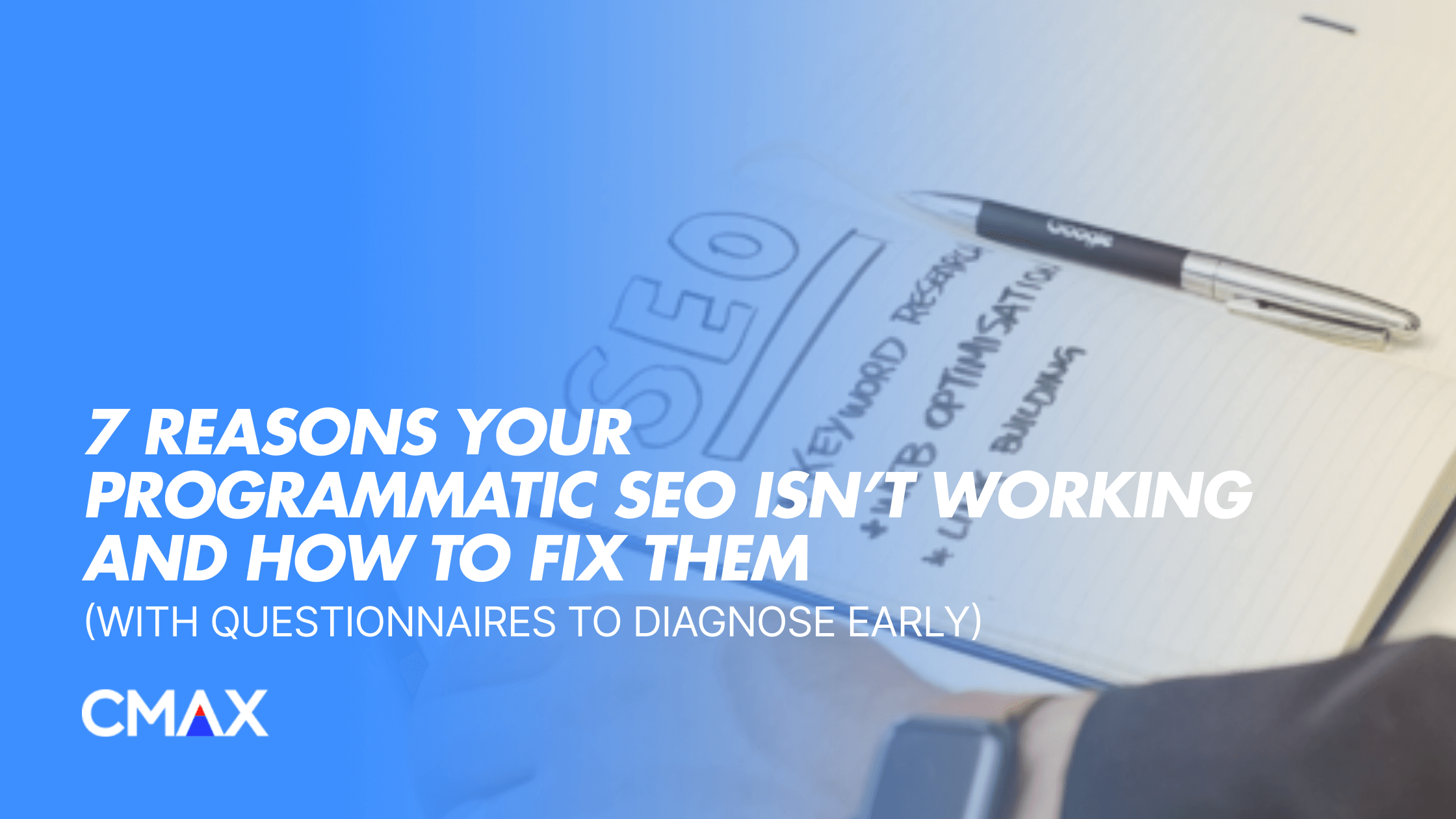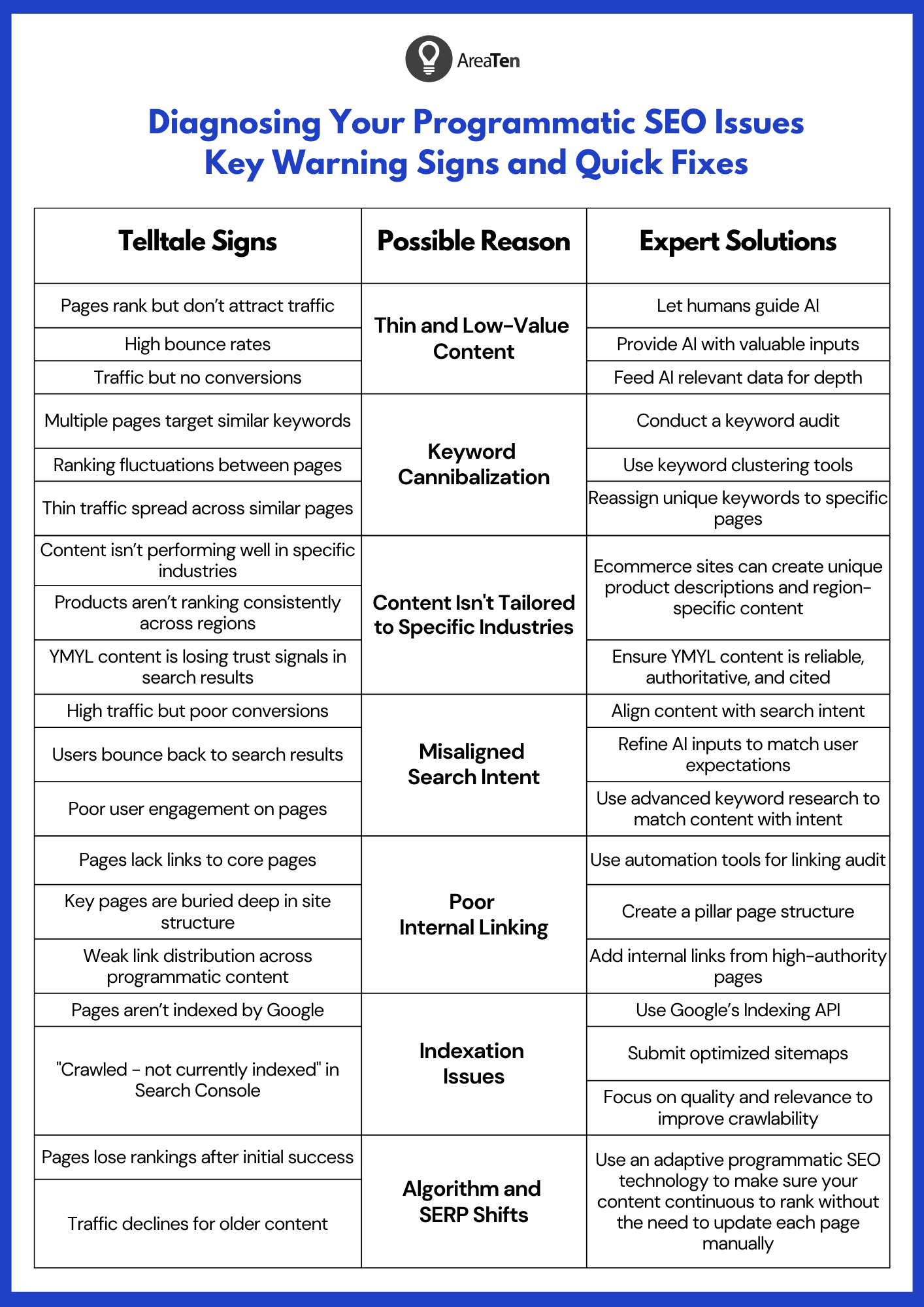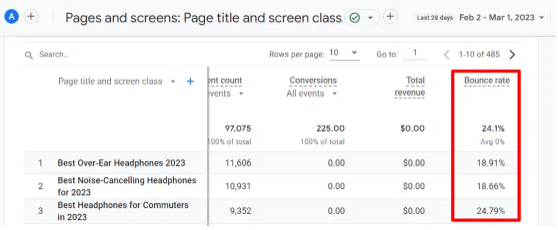A deep dive into programmatic SEO covering common issues and how to fix them. Diagnose the problems with our practical questionnaires and actionable fixes.
7 Reasons Your Programmatic SEO Isn’t Working and How to Fix Them


A deep dive into programmatic SEO covering common issues and how to fix them. Diagnose the problems with our practical questionnaires and actionable fixes.
A deep dive into programmatic SEO reveals that while it can be highly effective, it often encounters challenges like thin content, poor internal linking, and keyword cannibalization. This guide explores seven reasons your programmatic SEO might be underperforming and offers actionable fixes, along with diagnostic questionnaires to help you spot issues early.
When you notice that your digital marketing strategy isn’t working as expected, a deep dive into programmatic SEO might be able to bring major issues to light.
It’s easy to think you’ve got all the right elements—SEO automation, content, and keywords—but sometimes, the results just don’t add up. If you’ve done everything but your traffic still isn’t growing or your rankings are stagnant, there are likely a few hidden roadblocks in your way.
Programmatic SEO is a strategy designed to automate the creation of large volumes of SEO-optimized content.
This method is a great way to target long tail keywords in particular, which make up roughly 70 percent to 90 percent of all search traffic.

Instead of manually crafting individual posts, you can use programmatic SEO to scale up your content production, drastically reducing the effort and time needed to make content. With programmatic SEO, you can dominate niche search terms and outpace competition without the manual labor of traditional SEO.
It’s like having a powerful content machine working for you around the clock.
As technology advances, traditional SEO is becoming less effective. If you try manually to produce content for each of the thousands of long tail keywords you want to target, then you’ll just end up wasting precious time, money, and effort with no real results to show for it.
According to industry research, on average, roughly 35 percent of successful bloggers spend over six hours on a single blog post (Source: Statista). Now, imagine doing that for thousands of posts, each targeting a different longtail keyword. It’s just not realistic.
That’s where programmatic SEO comes in. AI automates the content creation process and creates tons of content in a fraction of the time it takes traditional methods to do so. If you’re measuring up traditional SEO vs programmatic SEO, the former just doesn’t come close in this situation.
You save precious resources and still hit those hard-to-reach long tail keywords.
Programmatic SEO is amazing, but it’s by no means a magic spell that guarantees success. In fact, a lot of campaigns miss the mark due to some common mistakes.
For instance, if you’re not paying close attention, programmatically generated content can turn out thin and repetitive—in other words, useless to your target audience. For SEO content creation, that’s probably the top thing you want to avoid. To make matters worse, issues like keyword cannibalization and weak internal linking can seriously hurt your campaign’s performance.
To help you assess if your strategy is at risk, we’ve made a chart you can refer to. 
And to help you go through it strategically, we’ve included diagnostic questionnaires below that identify frequent pitfalls and offer solutions to fix them.
Thin content can really mess with your SEO. It’s the type of stuff that gives little to no value to your readers—think duplicate pages, scraped content from other sites, or “doorway” pages that are just there to trick search engines.
You see, Google’s all about promoting content that shows off your experience, expertise, authority, and trustworthiness (E-E-A-T), especially for YMYL (Your Money Your Life) industries. If your content doesn’t measure up, it’ll likely get buried in the search results. And when your content is low-quality, people tend to leave your site quickly, which tells Google that users aren’t finding what they need.
Programmatic SEO can pump out content super fast, but without a bit of human oversight, it often ends up feeling repetitive and bland.
It’s great for speed, but this might come at the cost of depth or real value. And you know what comes next: Users won’t care about it, and Google will label it as “thin content,” hurting your rankings.
So, how do we prevent this? The secret ingredient is none other than the human touch.
The key to nailing programmatic SEO is blending AI with human insight right from the get-go.
Instead of letting AI do its thing unchecked, guide it with clear instructions right from the start. The contextual and insightful data you feed the AI tool helps it stay on track, allowing it to deliver more meaningful, relevant content. Take the time to steer the AI upfront with the right input, and you avoid the hassle of having to edit the mass-produced content later.
To show you how even small tweaks along the way can make a huge difference in the final outcome, take a look at the two examples below.

As you can see, using refined inputs leads to more targeted, valuable results.
Keyword cannibalization happens when multiple pages on your site are going after the same keyword.
Instead of boosting your SEO, it actually splits your SEO power. Search engines can get confused, and they won’t know which page to rank higher. This often leads to lower rankings for all of them. It’s like your own team members competing with each other instead of working together for success.
When your pages are fighting for attention, your overall visibility is going to take a serious hit.
When you skip a thorough review during the planning stage, it’s easy for multiple pages to end up targeting almost identical long-tail keywords.
AI tools can make this problem worse by producing content with terms that are super similar, even if the differences seem minor. Without a solid keyword strategy and some human oversight, your programmatically generated content can quickly become redundant.
That’s why taking the time for detailed keyword planning and regular reviews is key to keeping things on track and avoiding this kind of issue.
Before you even start using your AI tools, take a moment to apply some data-driven SEO techniques in your keyword research.
For any published content, it’s a good idea to run a check with Google Search Console to spot competing pages. From there, assign unique keywords to each page and organize similar pages into a pillar structure. This approach can give your rankings a solid boost.
Also, don’t forget about keyword clustering tools—they’re great for figuring out which terms should be prioritized on each page, preventing any overlaps.
Don’t neglect your keyword strategy, and you’ll see your SEO performance soar.
In eCommerce, the primary focus is often on product variations and regional targeting.
When creating content programmatically, you need to highlight unique product features and adjust details based on location. This could include things like:
The trick is to make each page valuable and not repetitive. Keep that in mind, and your search rankings will thank you.
Now, when it comes to YMYL industries, things are a bit different. For example, any lawyer SEO agency worth their salt knows that programmatic SEO content needs to focus more on building credibility and staying compliant with regulations.
Customizing content based on regulatory requirements and demographic needs is crucial. For instance, a legal website offering advice on divorce proceedings should adjust its information based on the user’s location to reflect state-specific laws and regulations. This level of customization not only builds trust but also keeps you compliant.
Prioritizing these factors goes a long way in making your content more reliable and authoritative.
For eCommerce sites, one of the best things you can do is to focus on creating unique, varied product descriptions to help your offerings stand out in the market.
What’s more, with 18% of local smartphone searches leading to same-day purchases (Source: Forbes), creating regionally tailored content that targets those queries is also essential.
For YMYL industries, it’s extra important to ensure your content isn’t just unique but also reliable and authoritative.
Make sure you implement strict quality checks and back your content with expert sources. Our proprietary system, CMAX, can be trained on approved content sources, so it generates high-quality, trustworthy content at scale. This way, you’ll keep up your standards while producing a lot of content.
When your content doesn’t align with what users are searching for, they leave your page frustrated. It’s sort of like expecting a fancy dinner and being given fast food instead—it’s just disappointing.
If you want to gauge how users feel about your content, just take a look at your bounce rates and how long people stay on your site.
(Source: MonsterInsights)
When visitors leave your site quickly, it might suggest they’re not finding what they need. While bounce rate isn’t a direct ranking factor, Google does track how users interact with search results. If people click on your page and then swiftly return to the search results to choose another link, Google considers this behavior.
Such actions can indicate that your page didn’t meet the searcher’s intent. Over time, this can affect your page’s credibility and potentially lower your rankings, impacting your traffic and visibility.
While using AI for SEO can definitely help scale content production, it’s not always great at nailing down search intent.
For instance, an AI may generate pages targeting a broad keyword like “best fitness tracker” without differentiating between “informational” and “transactional” queries. This failure to capture the nuances behind searcher intent means you might get traffic but not conversions. Users arriving for information won’t buy, and those ready to purchase might not find the details they need.
Another issue with AI is hallucination—basically, it might create content that’s inaccurate or just plain misleading. For obvious reasons, you don’t want to rely on this to create content (especially if you’re operating in the YMYL industry). Google’s own AI Overviews have come under fire for this.
(Source: Search Engine Land)
(Source: Search Engine Land)
Now, just think what would happen if content as comically inaccurate as this ended up on your website, the face of your precious brand on the internet. That would be a complete nightmare for your credibility.
First things first—start by digging into keyword research. Tools like Ahrefs or SEMrush can really help you figure out what people are looking for, whether it’s info, directions, making a purchase, or just comparing product options.
Grouping your keywords based on the different types of search intent (information, navigation, transactions, or commercial) helps create useful content like product guides, how-to articles, or side-by-side comparisons.
Next, you want to make sure your AI knows what to aim for. To do this, clearly define the data and prompts you’re feeding into it so it can produce results that align with what people actually want.
And we do want to emphasize this: don’t let AI do all the heavy lifting on its own. Human oversight is crucial in the programmatic SEO process, fact-checking and fine-tuning initial batches of content to ensure that everything is accurate and trustworthy.
SEO services that add a human touch early on can make your AI-generated content feel more authentic, improving engagement and boosting your brand’s credibility.
Internal linking is critical for distributing authority across your site, helping search engines crawl it as effectively as possible.
Good internal linking improves your site’s architecture, making it easier for your users to find your most important web pages. Plus, when you guide visitors to related content, they spend more time on your site, which can lead to better rankings.
In fine-tuning your internal links, you help search engines understand and value your content better.
The bad news is, without proper oversight, internal linking can easily be overlooked in programmatic SEO.
Large-scale content creation often fails to correctly implement strategic internal linking, leaving important pages isolated. These orphaned pages will then struggle to gain the authority they need to rank well, even if the content is amazing.
If you want to make sure that all of your web pages receive the SEO benefits they deserve, you need clear internal linking in place.
To fix poor internal linking, you can automate the process using Excel or custom scripts. Here’s what you should do:
By doing this, you’re building a stronger site structure and making sure everything’s connected, which can seriously improve your overall SEO performance.
Here are the most common things to look out for:
Pages that are not indexed will never rank in Google search.
Bottom line: you need a solid indexing strategy to get the most out of your SEO efforts. Otherwise, your amazing content won’t reach the audience it deserves, and every unindexed page is a lost chance to grow your organic traffic.
Getting started with Google’s Indexing API is a game changer if you want to speed up the indexing process.
First, you’ll need to enable the API and set up a service account through Google Cloud. Once your site is verified in Google Search Console, you can obtain an access token to authenticate API calls. With this API, you can notify Google of new, updated, or deleted pages for quick indexing.
Just keep in mind that although the indexing API is faster than sitemaps, submitting a sitemap is still recommended for full site coverage.
Even if you’ve managed to get your programmatic content to rank well at first, you might notice your position in the search results bouncing around over time.
One key reason is that competitors are also regularly uploading similar content. As more of that hits the web, the search engine results pages (SERPs) start shifting, and your content can get pushed down unless you’re keeping an eye on it and making adjustments.
If you want to maintain your high rankings, you need to stay vigilant.
Another significant factor affecting your rankings is Google’s frequent algorithm updates.
These updates often change the criteria for ranking content, which means that programmatic SEO pages that performed well under previous rules may see a drop in rankings after a new update. Staying on top of these changes is key to keeping your SEO game strong, so regular adjustments are a must to stay aligned with Google’s shifting standards.
Manually keeping up with thousands of pages as SEO trends shift? That’s a massive time sink and, honestly, not realistic.
The solution? Use programmatic SEO technology that adapts in real-time to changes in competition and algorithm updates. These tools give you the flexibility you need to keep your content optimized and competitive.
With the right tech in place, staying ahead of SEO shifts becomes way more manageable.
AI is advancing quickly, but let’s be real—not every tool is great for SEO.
Models like ChatGPT, for example, are super popular, but with so many people using them, you can end up with content that looks pretty similar across the board. This can actually hurt your SEO, as duplicate content might lead to penalties.
On top of that, generic tools often churn out copies that feel templated. That means it might fail to match your brand’s unique voice, miss important SEO opportunities, or even overlook legal guidelines. What’s more, most of these tools create static content that can’t keep up with all the constant changes to search algorithms.
If you want to stay ahead of the competition, you need something more exclusive—tools that aren’t as easy for your competitors to get their hands on.
The programmatic SEO strategy our digital marketing agency uses effectively combines human insight with proprietary AI.
We start by having our team of expert writers create content that fits your brand and checks all the legal boxes. Once the initial content is approved, our proprietary technology, CMAX, takes over to automate content generation, cross-linking, and real-time optimization.
It’s an excellent blend of expert SEO copywriting services and AI automation, giving you high-quality, compliant, and optimized content all at scale.
CMAX is far from static—it uses Particle Swarm Optimization (PSO) to create dynamic content, automatically adjusting content strategies across your site.
Through this swarm intelligence, CMAX redistributes resources to underperforming pages, adjusting internal link structures to allow top-performing content to lift up weaker pages. This process keeps everything balanced and ensures your SEO is always improving.
And with CMAX constantly updating and optimizing in response to algorithm changes, you’re set up for long-term success in the ever-changing SEO game.
As a trailblazing SEO Accelerator, we amplify your SEO traffic 4x faster and at 10x the scale of traditional methods, thanks to our programmatic SEO technology and veteran expertise. With over a decade of experience, we provide 100% solutions and 0% excuses, delivering growth for businesses of all sizes. We even offer cutting edge solutions—like CMAX.ai.